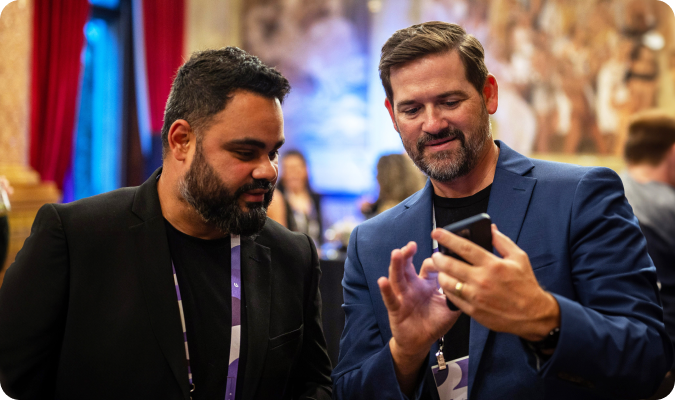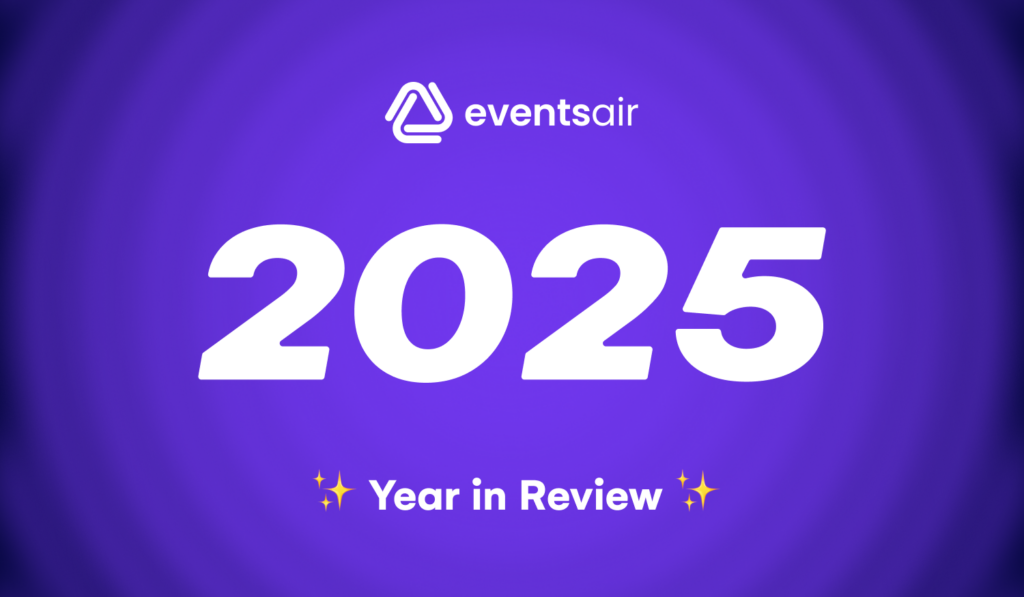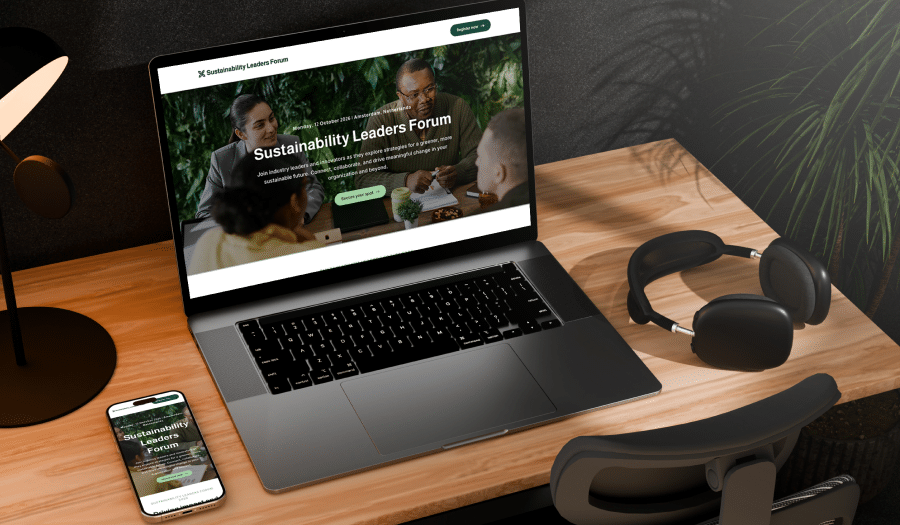
People love a good competition! That’s why games can make events more enticing, engaging, and memorable. An event gamification strategy can take attendees from silent observers to active participants in the entire event program.
We’re seeing more EventsAir customers adopt our gamification tools and in this article, we’ll explore why gamification is important and how to develop a gamification strategy that creates value for attendees, sponsors, and hosts.
What is a gamification strategy?
A gamification strategy takes the best elements of games, such as competition, achievement, rewards, and recognition, and then applies them in real-world situations to encourage desired behaviors and outcomes.
When it comes to event planning, gamification has become an expectation. Almost every event has a gamified layer, such as a live poll, event app, or social media competition. That’s why event planners need to go beyond thinking about what games they will have at their event. We also need to consider why we want to use them.
If you’re trying to implement event gamification, these are the strategic questions you need to ask:
- What behaviors do you want to encourage and why?
- What elements do you need to enable the game?
- What goals do you want to achieve with gamification?
- What games could help you achieve those goals?
- How could your gamification plan deliver engagement throughout the entire event?
- How will you know if your gamification strategy is effective?
Let’s explore how to create a gamification strategy that will elevate your event.
What behaviors do you want to encourage and why?
Many event planners start planning their gamification strategy by considering the attendee’s perspective first. They might ask themselves the following questions:
- What games would I want to complete if I were attending?
- What prize would I want to take home?
- How much effort would I put into this?
While these are important considerations, it’s also important for planners to think about their own perspective. To ensure that their event gamification strategy delivers meaningful outcomes that are aligned with the overall event goals, they should also ask:
- How do I want my attendees to engage?
- What behavior do I want to encourage?
- What am I looking to get out of that engagement?
When we balance these perspectives, we end up creating a positive experience for all event stakeholders. We heighten the atmosphere at our event, making the most of the time and resources that go into planning an exciting series of games.
What elements do you need to enable gamification?
There are a number of elements you need to motivate your attendees to get out of their comfort zone and compete. EventsAir has all of these set up as tools in its attendee and gamification app, so you can use technology to encourage participation and increase event engagement.
Goals
Goals are a set of structured tasks that you want your attendees to complete throughout an event. For example, they could be as simple as scanning a QR code at the door or responding to a live poll. Your event goals should always be aligned with the overall objectives of your event so you’re incentivizing people to complete tasks that will deliver value to your event stakeholders.
Points
Points are the currency of your gamification strategy. They are what attendees will gather as they achieve the goals you have assigned to them. You will need to attribute point values to each of your goals based on their priority.
Badges
Badges are the tangible symbols of achievement that participants will receive when they complete a goal. They are a fun way to acknowledge participants when they have completed a task. For example, you might want to award someone a social butterfly badge if they connect with lots of people at an event.
Rewards
Rewards are the tangible incentives for achieving the goals set in a game. They could be redeemable when a participant gathers a certain number of points or could be won by a prize draw.
Leaderboard
Leaderboards are a great way to encourage healthy competition. They provide a real-time display of how attendees are stacking up against each other, driving them to complete more goals.
What goals do you want to achieve with gamification?
You might have a number of gamification goals as an event planner. They should all encourage behaviors that will create ROI for your attendees, sponsors, speakers, and exhibitors. Here are some common examples:
Community building
Fostering a sense of community and belonging among attendees.
Data collection
Gathering valuable attendee data to refine event strategies and improve future planning.
Event app adoption
Increasing event app downloads to enhance the overall experience and gain valuable insights into attendee behavior.
Increased attendee engagement
Encouraging active participation in sessions, networking, and event activities.
Enhanced learning
Promoting knowledge retention and skills development among attendees.
Example activities and games for your gamification
Once you know your end goals, you can structure games and activities around them. For example:
- If you were trying to encourage community building, you could motivate attendees to use EventStream, a private social networking tool provided by EventsAir. Attendees could share posts, videos, and comments at the event in real-time, allowing them to digitally connect with other guests.
- Imagine your goal was to gather lots of attendee data. You could use games that encourage people to participate in session surveys and live polls throughout the conference program.
- If you wanted more people to start using your event app, you could use an “early adopter” gamification reward to get people to start downloading and using it as quickly as possible.
- Let’s say you wanted to enhance people’s learning. In that case, you could create trivia games based on keynote presentations.
When you’re clear on your goals, it’s easy to create effective games and articulate why you want people to play them to other stakeholders. This also makes the sell for sponsors to provide exclusive prizes and fun merchandise more compelling!
How could your gamification plan deliver engagement throughout the entire event?
Imagine that the key outcome you want to deliver at your event is a stronger network between attendees and sponsors. Think about how you could plan activities that would encourage your attendees to introduce themselves to others, have meaningful conversations, and exchange details throughout the event.
Pre-event
Set a goal that encourages guests to download your event app before the event, create a profile, and start connecting with other guests. Everyone’s profile could explain why they are attending the event and what value they can provide to other guests. This will make it easy for people who want to build new networks to research other attendees before the event, set up meetings, and spend more time building relationships when they arrive.
During event
Reward your guests for attending networking activities and exchanging virtual business cards. You might even give them points for being brave enough to introduce themselves to one of your speakers or sponsors. It’s important that people feel comfortable at your event, so think about incorporating games that help to break the ice and connect people with similar goals.
Post-event
Why not reward attendees for scanning a QR code to sign up for an exclusive online community so that they can hold onto all of the exciting new relationships that they created at your event? Events are all about people and if attendees build long-lasting relationships that add value to their lives, they’re more likely to attend again in the future.
Building new contacts is also a great value-add for your sponsors. Consider putting them at the center of your community and use their brand name to encourage others to join.
How will you know if your gamification strategy is effective?
It’s easy to measure your success if you’re using an event management technology platform such as EventsAir. There are plenty of digital tools and components built into the platform that help you monitor gamification and event engagement at every touchpoint.
In the first instance, you will know your games are popular based on how many attendees are completing their goals and gathering points. You can also monitor how many people are redeeming their prizes. The EventStream Wall and Leaderboard apps will also help you visualize how people are engaging with your games and where they are playing throughout your venue.
Your gamification strategy should evolve over time
If you’re setting clear event goals, striving to deliver stakeholder value, and measuring your success, your gamification strategy will get even better over time. Attendee behavior might change and sponsor expectations can shift, however, with these three goal posts in place, you can consistently deliver value.
About Hope Simona
Hope Simona is a Marketing and Events Coordinator at EventsAir who is passionate about the huge potential for events to impact communities, businesses, and individuals. She spearheads EventsAir’s presence at global trade shows and exhibitions, creating meaningful connections between our platform users and the core of the company.
This article was adapted from Hope’s AirTime 2023 presentation. If you would like access to more insights from the event technology team at EventsAir, then register for AirTime 2024.
Attendee Engagement | Attendee Experience | Event Planning & Management | Event Technology & Apps
See EventsAir in action
Discover why 12,000+ event professionals trust EventsAir to deliver effortless events, every time.




